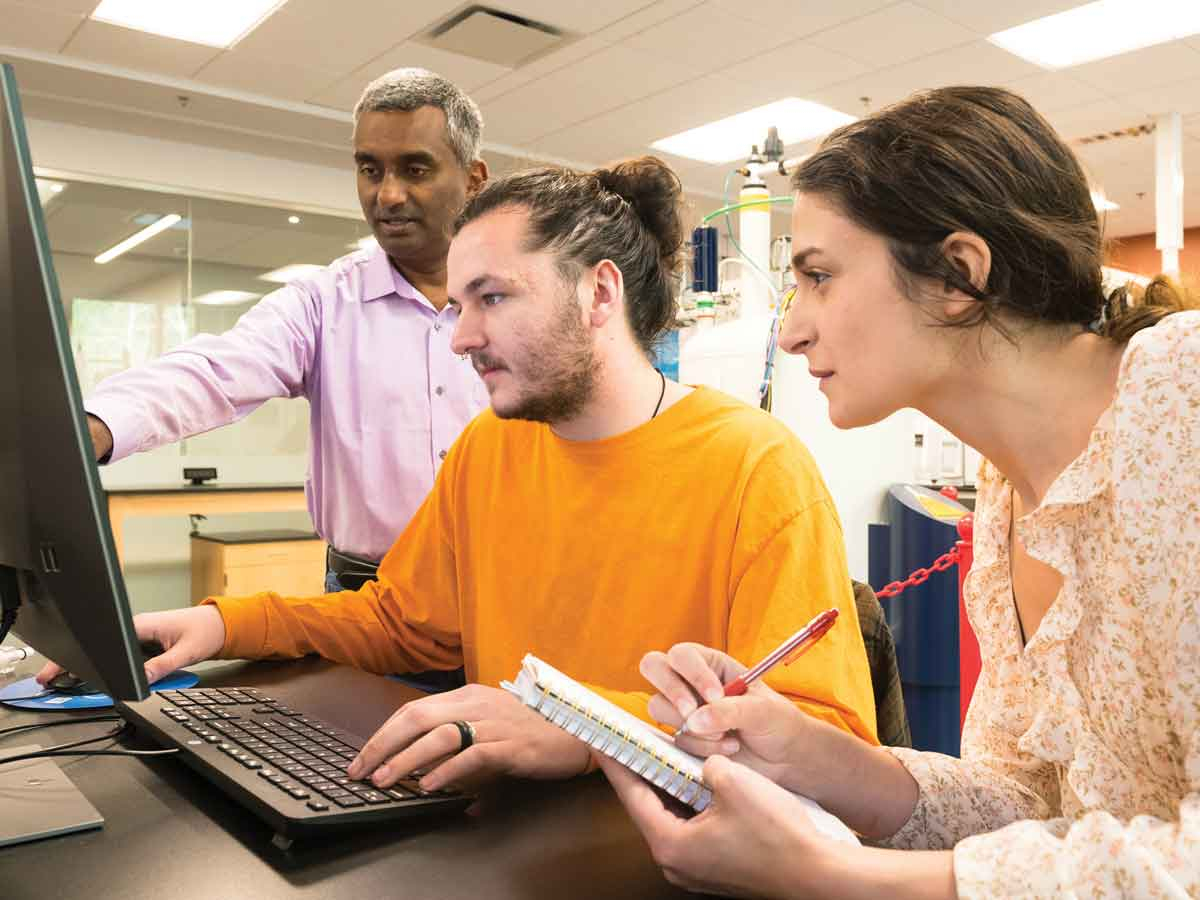WCU research takes aim at nuclear waste problem
 Associate professor Channa De Silva (left), Brandon Sanders and Caleigh Gress Byrd work together in a lab in the new Apodaca Science Building. WCU photo
Associate professor Channa De Silva (left), Brandon Sanders and Caleigh Gress Byrd work together in a lab in the new Apodaca Science Building. WCU photo
In global conversations about climate change, carbon neutrality and green energy, nuclear power plays a pivotal role. It’s responsible for one-fifth of the United States’ annual electricity supply and accounts for more than half of its low-carbon energy . Duke Energy customers in North Carolina get about half their power from nuclear energy.
Nuclear power is attractive because it requires only a small amount of material to generate an enormous amount of energy, with no airborne emissions. However, it does produce radioactive waste. While that waste doesn’t take up much space — according to the industry organization Nuclear Energy Institute, all the nuclear waste produced in the United States since 1950 would fit one football field, 10 yards deep — best practices for disposal are an ongoing discussion .
“The big problem in the United States and all over the world, is what do we do with the nuclear waste after we produce the nuclear power?” said Western Carolina University associate professor Channa De Silva.
Nuclear power is generated through a water-based reaction that releases large amounts of energy but leaves behind radioactive byproducts. Right now, there’s no way to clean or detoxify that waste.
In the U.S., used fuel spends its first five years outside the nuclear reactor in a pool of temperature-regulated water to cool it down and block radiation release during the period when most radioactive decay occurs. Then, it moves to long-term storage in a concrete-and-steel container, filled with inert gas designed to survive natural disasters. Though there’s intellectual consensus that it would be best to store these casks at one, consolidated location, preferably deep underground, political obstacles have prevented this from happening, so in the U.S. waste is stored on-site at the power plant where it was generated.
Through research he’s conducting with WCU students in partnership with U.S. Department of Energy scientists, De Silva hopes to come up with a better answer. Researchers want to find a way to extract and treat the radioactive elements of nuclear waste, so that in the future it can be transformed into clean water and material that won’t pose an acute danger — and might even inherit a new purpose.
Related Items
“What if we can remove everything nuclear waste, and then send that water back to the river? That will be cool, right?” De Silva said. “And then that nuclear waste that we are extracting, we can use for some other purposes.”
The material could have a second life in some other application — biomedical probes, for instance.
For now, that’s all hypothetical. But De Silva hopes his research will help make it factual.
“Our idea is to try to develop nuclear waste extracting agents,” he said. “That means a chemical that can go into the water and remove those nuclear or radioactive materials or metals.”
De Silva and recent WCU graduate Brandon Sanders submitted a research proposal to the Department of Energy, and they received funding through a visiting faculty program that partnered them with the Seaborg Institute at Los Alamos National Laboratory in New Mexico.
Los Alamos has powerful supercomputers that the two planned to use last summer to run simulations, evaluating the suitability of different types of phosphorus molecules for binding with radioactive elements in spent nuclear fuel. The pandemic prevented the researchers from traveling to New Mexico, but the new Apodaca Science Building that opened last fall now houses computers capable of handling the research on campus at WCU.
The researchers designed molecules, calculated their properties and then suggested the most promising combinations to the National Lab for future research. It’s exciting, but it’s still only one step in a long, collaborative process.
“The national lab will make these promising agents that we are proposing and they will do nuclear extraction in a laboratory setting over there in Los Alamos, and then they will give us feedback,” De Silva explained.
De Silva and his students will take those real-world results to design more efficient molecular arrangements, run new simulations and report those results to the lab. Through this feedback loop, scientists working on the problem hope to eventually end up with the right answer. It’s hard to say how long that will take, though De Silva hopes to see it happen within the next 30-40 years.
“We really need a solution pretty soon,” he said.













